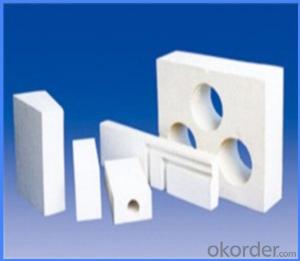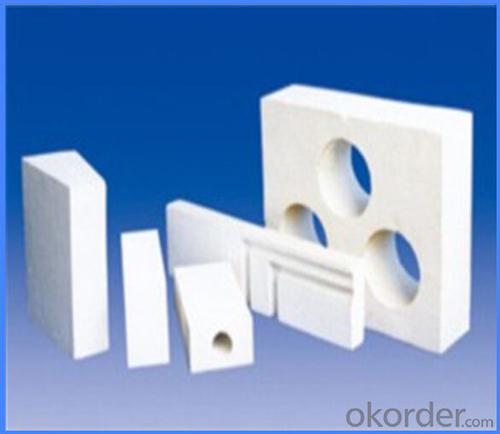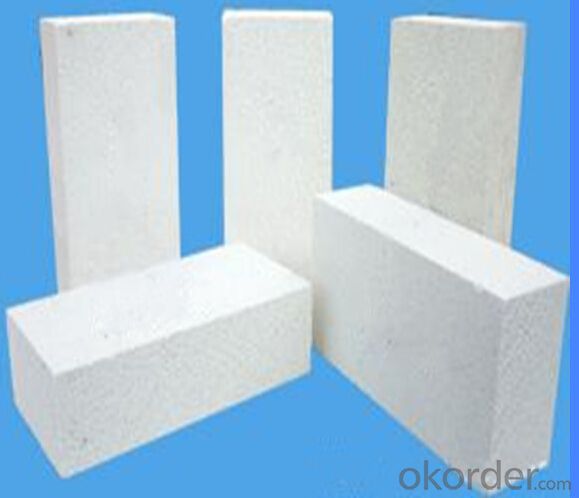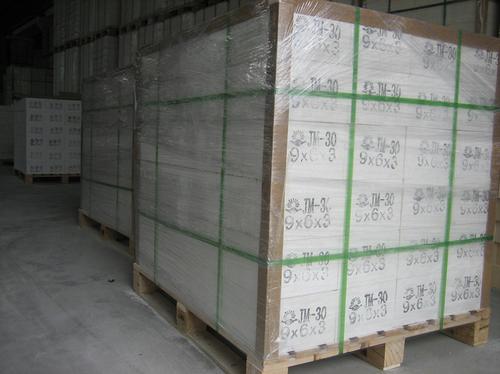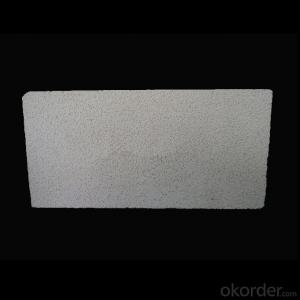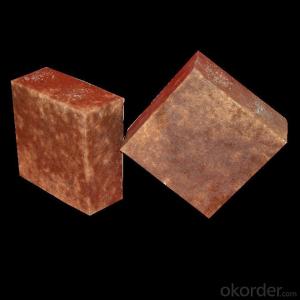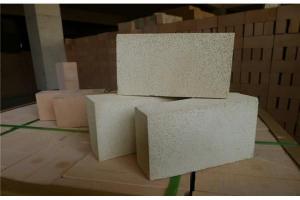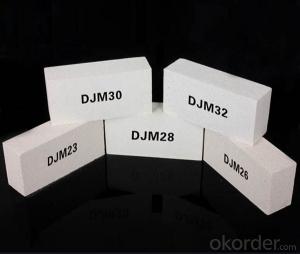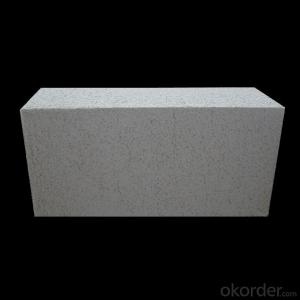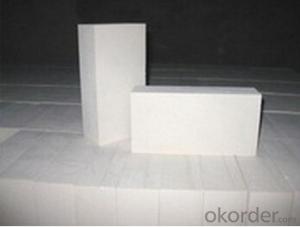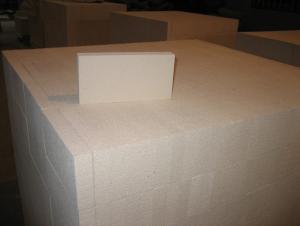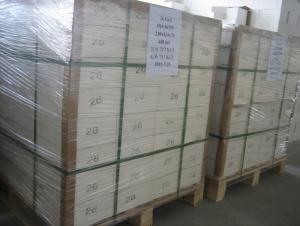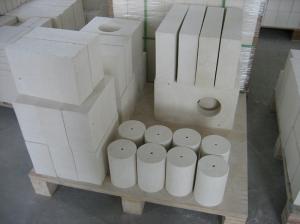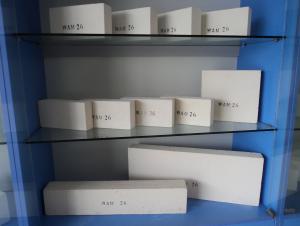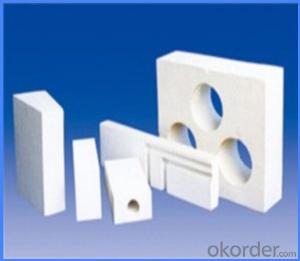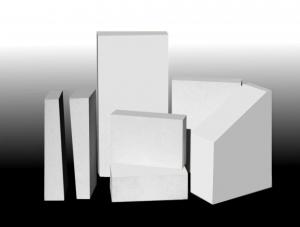Insulating Fire Brick - Refractory Mullite Insulating Refractory Brick JM 41
- Loading Port:
- Shanghai
- Payment Terms:
- TT OR LC
- Min Order Qty:
- 20 m.t.
- Supply Capability:
- 20 m.t./month
OKorder Service Pledge
OKorder Financial Service
You Might Also Like
General Information
CMAX insulating firebricks are classified under temperature between 1300℃ to 1700℃, manufactured from high purity alumina clay.
1. Lower content of iron, alkaline and impurities, good high temperature properties.
2. Homogeneous structure, light weight, energy saving because lower heat storage in the furnace during cooling cycles.
3. High strength, good thermal shock resistance under high temperature.
4. Precise sizes due to grinding and shaping after sintering, which meets the requirement of construction.
5. Max service temp: Up to 1730C (3160F)
Feature
Light weight and low thermal conductivity
Low heat storage
Low iron and impurities
High thermal shock resistance
Application of Insulating brick
Metallurgical Industry: blast furnace, hot blast furnace, heating furnace, etc..
Petrochemical Industry: ethylene cracking furnace, hydrogen furnace, the main furnace, heating furnace, etc..
Ceramic industry: roller kiln, kiln, etc..
Glass industry: glass furnace regenerator, etc.
Carbon industry: carbon furnace, etc..
Aluminum electrolysis industry: aluminum reduction cell, etc.
Other industries: tunnel kiln, shuttle kiln, etc.
Advantages of heat insulation brick
Low thermal conductivity: many air holes will bring good thermal insulation effect, energy saving.
High crushing strength: high crushing strength, volume stability.
Low heat storage: small heat storage, absorb more heat, energy-saving effect is obvious.
Technical Data
ITEM | GJM30 | GJM28 | GJM26 | GJM23 |
Classification Temperature, ℉/℃ | 3000/1650 | 2800/1540 | 2600/1430 | 2300/1260 |
Bulk Density,g/cm³ | ≤1.0 | ≤0.9 | ≤0.8 | ≥0.5 |
Reheating Linear Change, % | ≤0.9 (1550℃,12 h) | ≤0.8 (1510℃,12 h) | ≤0.7 (1410℃,12 h) | ≤0.5 (1230℃,12 h) |
Al2O3 Content, % | ≥75 | ≥65 | ≥55 | ≥45 |
Fe2O3 Content, % | ≤0.5 | ≤0.6 | ≤0.7 | ≤1.0 |
Thermal Conductivity: | ||||
800℃, w/m.k | ≤0.39 | ≤0.37 | ≤0.35 | ≤0.18 |
1000℃, w/m.k | ≤0.43 | ≤0.41 | ≤0.39 | ≤0.20 |
1200℃, w/m.k | ≤0.48 | ≤0.46 | ≤0.43 | --- |
Insulating brick
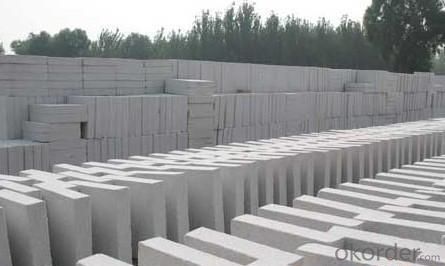
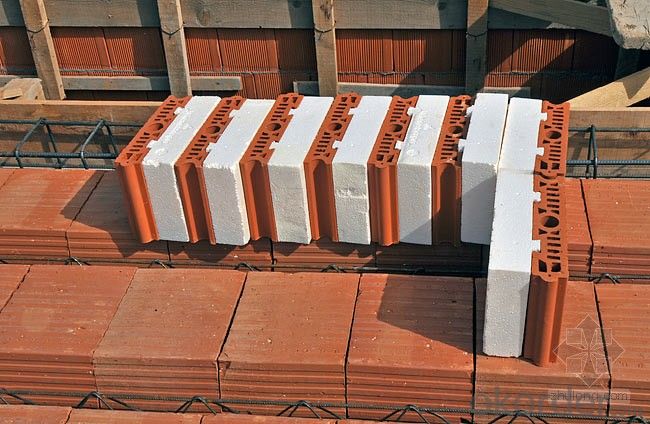
Common problem solution
1. What products do you have?
We have all kinds of refractory bricks, refractory casting materials, mortar, cement, ceramic fiber products, etc..
Or you can browse our products to choose what you need.
2. How to control product quality?
With strict quality control system throughout the material selection and production process, we have the quality of refractory materials and ceramic fiber products to meet customer requirements.
From the selection of raw materials, the quality of our control to start. The quality of the raw materials required for each batch of products in the use of the front line test. In the production process, through the quality control of workers, and then to each piece of classification, and through quality supervision and inspection.
3. Could you give me a brief introduction to the application of your product?
My Company is mainly engaged in steel, cement, glass, ceramics, petrochemical, electric power and other industries.
4. If I need you, what kind of information do you need?
In order to select the right products, we will provide us with information, such as the United States, technical data, order quantity, product applications, etc..
If you have any questions, please contact us.
- Q: Are insulating fire bricks resistant to phosphoric acid?
- Yes, insulating fire bricks are resistant to phosphoric acid.
- Q: Can insulating fire bricks be used in refractory coatings?
- Yes, insulating fire bricks can be used in refractory coatings. Insulating fire bricks are designed to have low thermal conductivity, which makes them effective for insulating applications. When used in refractory coatings, they can help to reduce heat loss and increase energy efficiency. Additionally, insulating fire bricks are capable of withstanding high temperatures, making them suitable for use in refractory coatings that are exposed to intense heat. However, it is important to consider the specific requirements and properties of the refractory coating, as well as the intended application, to ensure that insulating fire bricks are the most suitable choice.
- Q: What is the price of concrete self insulation bricks?
- If you really want to buy thermal insulation brick, do not simply look at the price, but also to consider the quality of the product. (a piece of brick in the market basically in 6 yuan, if there is a floating price if it is because of the size of the insulation brick or distance, but floating slightly.)
- Q: Can insulating fire bricks be used in the construction of glass fusing kilns?
- Yes, insulating fire bricks can be used in the construction of glass fusing kilns. Insulating fire bricks are designed to withstand high temperatures and provide excellent insulation, making them suitable for use in kilns. They help to retain heat and ensure even distribution throughout the kiln, which is essential for the glass fusing process. Additionally, insulating fire bricks are lightweight and durable, making them ideal for kiln construction. They can help to reduce heat loss, improve energy efficiency, and maintain a consistent temperature inside the kiln, which is crucial for successful glass fusing.
- Q: How do insulating fire bricks compare to other insulation materials?
- Insulating fire bricks, as insulation materials, possess several advantages over other options. Firstly, they exhibit exceptional thermal properties, enabling the efficient prevention of heat transfer. Their low thermal conductivity effectively insulates against high temperatures, making them ideal for heat retention in furnaces, kilns, and fireplaces. In comparison to fiberglass or mineral wool, insulating fire bricks prove significantly more durable and long-lasting. They withstand extreme temperatures without compromising their insulation or structural integrity. Consequently, their longevity makes them a cost-effective selection, necessitating less frequent replacement. Another benefit of insulating fire bricks lies in their resistance to chemical attack and wear. They exhibit resilience against acids, alkalis, and other corrosive substances, rendering them suitable for applications involving harsh chemicals or environments. Moreover, their high compressive strength allows them to bear heavy loads without cracking or breaking. This quality makes them suitable for structural applications that require weight-bearing capacity. Installation-wise, insulating fire bricks are easily workable. They can be cut, shaped, and installed using basic tools, offering customization and flexibility for diverse applications. Their lightweight nature simplifies the installation process and reduces overall structural weight. In conclusion, insulating fire bricks surpass other insulation materials in terms of insulation properties, durability, chemical resistance, and ease of installation. Their ability to endure high temperatures, resist wear and tear, and provide long-lasting insulation make them an exceptional choice for various industrial and domestic settings.
- Q: Can insulating fire bricks be used in refractory castings?
- Yes, insulating fire bricks can be used in refractory castings. These bricks are designed to have low thermal conductivity, making them suitable for applications where high insulation is required, such as in refractory castings. They provide excellent heat insulation and can withstand high temperatures, making them an ideal choice for various refractory applications.
- Q: How do insulating fire bricks help improve the efficiency of heat recovery systems?
- Insulating fire bricks play a crucial role in improving the efficiency of heat recovery systems in several ways. Firstly, these bricks are made from high-quality insulating materials such as ceramic fiber, which have excellent thermal properties. This means that they have a low thermal conductivity, preventing heat from escaping or being wasted. By using insulating fire bricks as lining materials in heat recovery systems, the heat exchange process becomes more efficient as less heat is lost to the surroundings. Secondly, insulating fire bricks help to reduce heat transfer through conduction. They act as a barrier between the hot and cold sides of the system, minimizing heat loss through direct contact. This insulation effect allows the heat recovery system to maintain a higher temperature on the hot side, maximizing the temperature difference and thus enhancing the heat transfer rate. Additionally, insulating fire bricks are lightweight and have low heat storage capabilities. This means that they require less energy to heat up and cool down, resulting in faster response times of the heat recovery system. This quick response enables the system to adapt rapidly to changes in heat generation or demand, improving its overall efficiency. Moreover, the use of insulating fire bricks as refractory materials in heat recovery systems helps to reduce energy consumption. Since these bricks can withstand high temperatures without cracking or deforming, they contribute to the longevity of the system, reducing the need for frequent repairs or replacements. This leads to lower maintenance costs and less downtime, ultimately improving the overall energy efficiency of the heat recovery system. In summary, insulating fire bricks enhance the efficiency of heat recovery systems by providing excellent thermal insulation, reducing heat loss through conduction, enabling quick response times, and minimizing energy consumption. Their use as lining materials significantly improves the heat transfer process, resulting in more effective heat recovery and utilization.
- Q: Can insulating fire bricks be used for high-temperature applications?
- Insulating fire bricks are widely employed for applications involving high temperatures. These bricks have been crafted to offer exceptional thermal insulation and endure extreme temperatures. Depending on the specific type and composition of the brick, they can typically withstand temperatures of up to 2600°F (1427°C) or even higher. Kilns, furnaces, and industrial settings that necessitate high temperatures commonly utilize insulating fire bricks. These bricks are renowned for their minimal thermal conductivity, which aids in reducing heat loss and enhancing energy efficiency. Moreover, these bricks possess the advantages of being lightweight, long-lasting, and resistant to thermal shock, rendering them ideal for environments with elevated temperatures.
- Q: Are insulating fire bricks suitable for insulation in boilers?
- Yes, insulating fire bricks are suitable for insulation in boilers. Insulating fire bricks are specially designed to withstand high temperatures and provide excellent thermal insulation, making them ideal for use in boilers. They help to reduce heat loss, improve energy efficiency, and enhance the overall performance of the boiler.
- Q: How do insulating fire bricks handle moisture?
- Insulating fire bricks have been specifically designed to effectively manage moisture. Composed of top-quality refractory materials, these bricks possess a minimal level of porosity. This characteristic plays a key role in preventing the infiltration of moisture into the bricks. Moreover, insulating fire bricks possess a compact structure and are often covered with a safeguarding sealant or glaze, which further diminishes their vulnerability to moisture. This combination of low porosity and protective coating confers upon the bricks the ability to withstand the detrimental impacts of moisture, including cracking, deterioration, or compromised insulating capabilities. Ultimately, insulating fire bricks have been meticulously engineered to skillfully handle moisture, guaranteeing their resilience and optimal performance in a diverse range of high-temperature applications.
Send your message to us
Insulating Fire Brick - Refractory Mullite Insulating Refractory Brick JM 41
- Loading Port:
- Shanghai
- Payment Terms:
- TT OR LC
- Min Order Qty:
- 20 m.t.
- Supply Capability:
- 20 m.t./month
OKorder Service Pledge
OKorder Financial Service
Similar products
Hot products
Hot Searches
Related keywords
